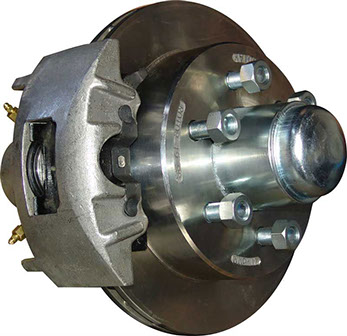Trailer Disc Brakes
Disc brakes are composed of a hub and attached disc or rotor, with a separate caliper unit which bolts onto the trailer axle. Within the caliper, brake pads sit either side of the disc/rotor and to put it simply, squeeze the disc by either mechanical or hydraulic power.
As with drum brakes, disc brakes have greater braking torque as they increase in diameter. As a rough guide, for every 1% increase in disc diameter, the braking efficiency increases by 1% due to the leverage gained as the caliper moves away from the axle. Larger diameter brakes also allow better dissipation of heat generated from heavy or constant braking.

Ideally the best braking comes from bigger rotors and the appropriate caliper piston to force it against the rotor. Calipers come in many options with single or multiple piston arrangements, cast iron, alloy or stainless bodies, differing piston materials from phenolic compounds, brass, or stainless and even the option of fitting a manual handbrake system to the calipers. Just make sure that the caliper, rotor and axle yoke are all compatible.
NOTE – When purchasing always make sure that the stub axle is matched to the rotor and caliper setup as the yoke design is normally caliper/rotor specific.
The load rating for disc brakes range from 2000 lb up to 9000 lb per axle and have larger bearing arrangements and larger rotors as the load capacity increases. Caliper sizes normally remain the same across the range although on the heavier duty models there is sometimes the option of a double yoke axle for fitting an additional caliper. (You may need to upgrade to a larger master cylinder reservoir on your coupler if more than one set of calipers are used)
NOTE - It is a good idea to take your wheel along to the supplier and do a dry setup of the hub/rotor and caliper before purchasing, to make sure that there is sufficient clearance within the wheel.
Different suppliers will offer choices of fully cast one piece rotor and hub which are reasonably cheap to purchase and they have the advantage of being robust, have some cooling capacity due to an air gap between the rotor and the bearing enclosure and being readily available. The rotor can be machined if it gets damaged, pitted or scoured although your trailer will be off the road while this is being done.
More commonly available now are bolt on rotors which are a little more expensive to purchase but have quite a few advantages.
Depending on the brand, vented rotors (to assist in keeping the rotor/calipers and hubs cool) are available and rotors also come in various materials from cast iron, stainless steel and bronze. The latter two rotor materials are more suitable for marine applications such as boat trailers.
If the rotors are damaged or scoured, they are easily replaced or removed for machining.
Various stud patterns are available to suit most common rims and blank hubs (un-drilled) are also available. Hubs are also available either in bare steel, painted, zinc plated and galvanized and for most applications either zinc plated or galvanized are recommended.
Hydraulic disc brakes are one of the most dependable braking systems available, and are simple to maintain and repair as long as they are looked after and treated with a little care. Disc brakes are the perfect brake for boat trailers, although regular cleaning and maintenance is required.